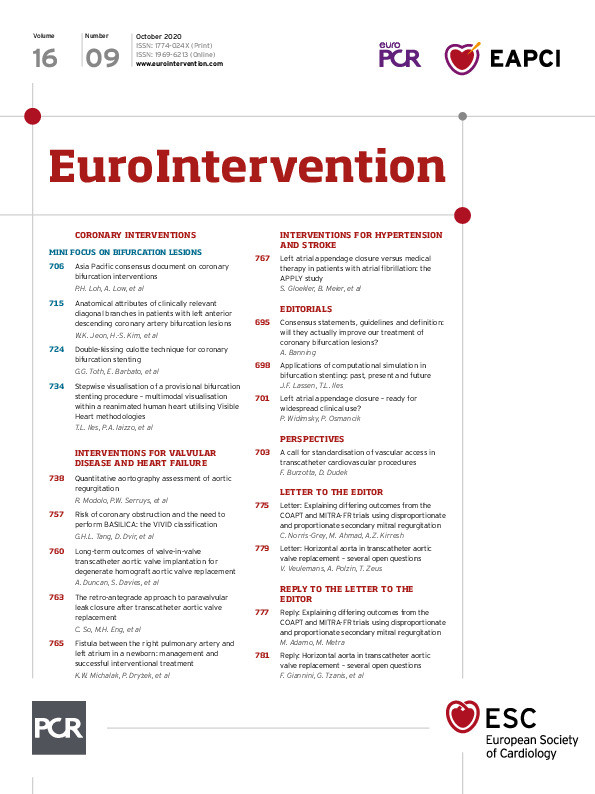
We are thankful to Norris-Grey and colleagues for their comments1 about our paper2. There are a few considerations needed with respect to this letter.
First, our results should not be considered in contrast to Grayburn’s hypothesis. There are two main explanations for the lack of differences in outcomes of patients with proportionate and disproportionate mitral regurgitation (MR). First, the sample size was relatively small and, using Grayburn’s definition2, the percentage of patients with proportionate MR was also low (22%). In addition, we had patients with “over-disproportionate” MR due to excessive effective regurgitant orifice areas (EROAs) less likely to be completely reduced. This latter aspect, as pointed out also by Norris-Grey et al, is the most relevant since MR >1+ at 30 days was the strongest predictor of poor outcome in our study2. Indeed, the likelihood of having optimal procedural results should be considered as a major factor for the selection of MitraClip candidates4.
In addition to procedural results, Norris-Grey et al mention the possible impact of left atrial pressure (LAP) on MitraClip outcomes5. They speculated that patients with normal LAP, having lower EROA, would have proportionate MR. However, no information about the relationship between MR severity and LV dimensions is reported in the study they cite. Moreover, chronic lung disease, but not LAP, was an independent predictor of outcome in that study5. Unfortunately, in our cohort LAP was available in less than 50% of patients; therefore, this parameter was excluded from the analysis. On the other hand, chronic lung disease was not associated with outcomes. However, in larger cohorts at longer follow-up, it was reported as a predictor of adverse events6. Intraprocedural monitoring of LAP is now recognised as paramount to guide the procedure and evaluate the MitraClip result. However, according to the above observations, a right heart catheterisation would also be helpful in the screening phase, especially in patients with a history of pulmonary disease, in order to identify those whose symptoms and/or pulmonary hypertension have a post-capillary component that may benefit from MR correction.
Finally, regarding the post-marketing surveillance results, we would like to clarify that the analysis included all the reports of adverse events; therefore, the proportion of injuries, such as damage to the mitral valve apparatus (8%), was calculated on the total number of adverse events instead of the total number of patients treated7. Intraprocedural mortality and complications of the MitraClip procedure are very low and valve damage is extremely rare8. However, as stated by Norris-Grey et al, centre experience plays an important role9. In our study, two medium- and one high-volume centres were included; no differences were found in procedural complications or MR >1+ at 30 days among different centres (79% versus 67% versus 64%; p=0.312).
On the other hand, two-year mortality was quite high (39%) but perfectly in line with previous registries and trials10,11. This is due to the high-risk profile of the patients treated, mostly affected by heart failure and other comorbidities. In this regard, further investigation for better selection of patients who may have a long-term benefit from this procedure is definitely needed.
Conflict of interest statement
M. Metra received consulting honoraria, for participation in steering committees or advisory boards or for speeches, from Abbott, Amgen, AstraZeneca, Bayer, Edwards, Fresenius, Novartis, and Servier. M. Adamo has no conflicts of interest to declare.
Supplementary data
To read the full content of this article, please download the PDF.

